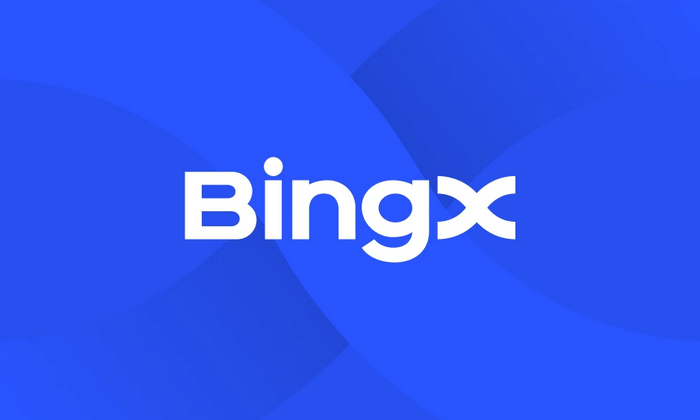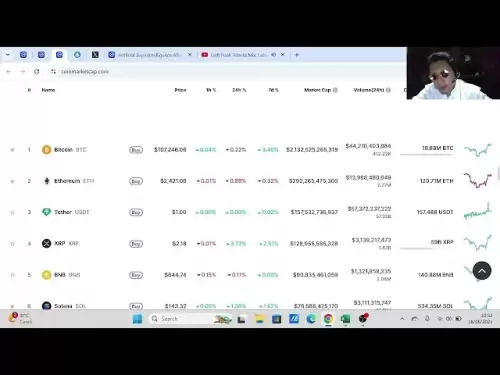-
 Bitcoin
Bitcoin $107,360.0175
0.36% -
 Ethereum
Ethereum $2,425.2303
-1.15% -
 Tether USDt
Tether USDt $1.0003
-0.01% -
 XRP
XRP $2.1850
4.33% -
 BNB
BNB $646.4128
0.37% -
 Solana
Solana $146.0511
2.89% -
 USDC
USDC $0.9998
-0.01% -
 TRON
TRON $0.2754
1.55% -
 Dogecoin
Dogecoin $0.1626
0.80% -
 Cardano
Cardano $0.5599
0.49% -
 Hyperliquid
Hyperliquid $37.2026
0.62% -
 Bitcoin Cash
Bitcoin Cash $499.0346
0.17% -
 Sui
Sui $2.7251
2.86% -
 Chainlink
Chainlink $13.1187
-0.19% -
 UNUS SED LEO
UNUS SED LEO $9.0747
0.54% -
 Avalanche
Avalanche $17.6526
0.87% -
 Stellar
Stellar $0.2373
1.02% -
 Toncoin
Toncoin $2.8387
0.25% -
 Shiba Inu
Shiba Inu $0.0...01136
1.04% -
 Litecoin
Litecoin $85.2460
1.04% -
 Hedera
Hedera $0.1473
2.04% -
 Monero
Monero $314.3978
1.56% -
 Bitget Token
Bitget Token $4.6799
0.81% -
 Dai
Dai $1.0001
0.02% -
 Polkadot
Polkadot $3.3403
0.70% -
 Ethena USDe
Ethena USDe $1.0002
0.02% -
 Uniswap
Uniswap $6.9908
0.77% -
 Pi
Pi $0.5310
-3.57% -
 Pepe
Pepe $0.0...09292
-0.19% -
 Aave
Aave $254.8721
-2.23%
BingX contract arbitrage guide
For successful contract arbitrage, identify price discrepancies between exchanges, calculate potential profit, select reliable exchanges with competitive fees, and carefully execute synchronized trades while managing risk and maximizing profit through partial exits and conditional closure techniques.
Nov 25, 2024 at 08:15 pm

BingX Contract Arbitrage Guide: A Comprehensive Step-by-Step Tutorial
Introduction
Contract arbitrage is a trading strategy that involves taking advantage of price differences between two or more crypto exchanges. By executing carefully timed and synchronized trades, traders can capitalize on these discrepancies to generate profit. This guide will provide a detailed overview of contract arbitrage on BingX, including the necessary steps, potential risks, and best practices.
Step 1: Understanding Contract Arbitrage
a. Identify Price Discrepancies: The first step in contract arbitrage is to identify price differences between exchanges. This can be done by using market data analysis tools or comparing prices manually across multiple platforms.
b. Calculate Profit Potential: Once price discrepancies are identified, the next step is to calculate the potential profit. This involves determining the spread between the two prices, taking into account trading fees and any other transaction costs.
c. Determine Arbitrage Triangle: Arbitrage triangles are the most common structure for contract arbitrage. They involve buying a contract on one exchange, selling it on another, and using the proceeds from the sale to buy back the contract on the original exchange.
Step 2: Choosing the Right Exchanges
a. Liquidity and Trading Volume: Select exchanges with high liquidity and trading volume to ensure that orders can be executed quickly and efficiently at competitive prices.
b. Trading Fees: Compare trading fees between different exchanges. High fees can significantly reduce the profitability of arbitrage trades.
c. Security and Reliability: Choose exchanges with a strong security record and reliable trading infrastructure to minimize the risk of losses due to platform failures or security breaches.
Step 3: Setting Up Your Trading Account
a. Create Accounts on Multiple Exchanges: Register for accounts on the exchanges you have chosen and complete the necessary KYC requirements.
b. Deposit Funds: Deposit sufficient funds into your trading accounts to cover both the initial investment and any margin requirements for the arbitrage trade.
Step 4: Executing the Arbitrage Trade
a. Place the Initial Order: Buy the contract on the exchange with the lower price using the designated trading account.
b. Place the Second Order: Simultaneously sell the contract on the exchange with the higher price using the other trading account.
c. Monitor the Trades: Closely monitor the execution and settlement of both trades to ensure that they are completed successfully.
Step 5: Managing Risk and Maximizing Profit
a. Manage Positions: Keep a close eye on the price movements of the contract and adjust positions accordingly to minimize losses and maximize profits.
b. Limit Market Exposure: Use stop-loss orders or conditional closure techniques to limit potential losses in the event of adverse price fluctuations.
c. Take Partial Profits: Consider taking partial profits at predetermined targets to lock in gains and reduce the overall risk of the trade.
Step 6: Troubleshooting and Advanced Strategies
a. Resolving Execution Delays: If one of the orders fails to execute due to delays or technical issues, consider canceling the opposing order and re-evaluating the arbitrage opportunity.
b. Exploiting Market Movements: Monitor market news and events that may affect the price of the contract being traded and adjust strategies accordingly.
c. Leveraging Multiple Arbitrage Triangles: For experienced traders, considering multiple arbitrage triangles simultaneously can enhance profit potential while diversifying risk.
Disclaimer:info@kdj.com
The information provided is not trading advice. kdj.com does not assume any responsibility for any investments made based on the information provided in this article. Cryptocurrencies are highly volatile and it is highly recommended that you invest with caution after thorough research!
If you believe that the content used on this website infringes your copyright, please contact us immediately (info@kdj.com) and we will delete it promptly.
- Across Crypto Project Faces Heat: Secret $23M Transfer Sparks Governance Debate
- 2025-06-28 16:30:13
- Trump Coin's Wild Ride: Liquidity Drain, Exchange Deposits, and What It Means for Binance & OKX
- 2025-06-28 16:50:13
- Solana, XRP, and Spot ETFs: A New York Minute on Crypto's Shifting Sands
- 2025-06-28 17:10:13
- Trump, Memecoin Mania, and Whale Watching: A New York Minute in Crypto
- 2025-06-28 16:30:13
- Gemini, Tokenized Stocks, and Europe: A New Era for Investment?
- 2025-06-28 17:10:13
- Shiba Inu, Lending Coins, and Early Holders: A New Frontier
- 2025-06-28 16:51:59
Related knowledge

How to use the price slope to filter the false breakthrough signal of the contract?
Jun 20,2025 at 06:56pm
Understanding the Concept of Price Slope in Contract TradingIn contract trading, especially within cryptocurrency derivatives markets, price slope refers to the rate at which the price changes over a specific time period. It helps traders assess the strength and sustainability of a trend. A steep slope may indicate strong momentum, while a shallow slope...

How to determine the expected volatility of the contract through the volatility cone?
Jun 19,2025 at 12:28pm
Understanding the Basics of Volatility in Cryptocurrency ContractsIn the realm of cryptocurrency trading, volatility is a key metric that traders use to assess potential risk and reward. When dealing with futures contracts, understanding how volatile an asset might become over time is crucial for position sizing, risk management, and strategy developmen...

How to formulate a contract intraday trading plan in combination with the pivot point system?
Jun 21,2025 at 03:42pm
Understanding the Basics of Pivot Points in Cryptocurrency TradingPivot points are technical analysis tools used by traders to identify potential support and resistance levels. These levels are calculated using the previous day's high, low, and closing prices. In the context of cryptocurrency trading, where markets operate 24/7, pivot points help trader...

How to adjust the contract position ratio through the price fluctuation entropy?
Jun 22,2025 at 11:42am
Understanding Price Fluctuation Entropy in Cryptocurrency ContractsIn the world of cryptocurrency futures trading, price fluctuation entropy is a relatively new concept used to measure market volatility and uncertainty. It derives from information theory, where entropy refers to the degree of randomness or unpredictability in a system. In crypto contrac...

How to use the volume swing indicator to predict the contract volume-price divergence?
Jun 18,2025 at 11:42pm
Understanding the Volume Swing IndicatorThe volume swing indicator is a technical analysis tool used primarily in cryptocurrency trading to evaluate changes in volume over time. Unlike price-based indicators, this metric focuses solely on trading volume, which can provide early signals about potential market reversals or continuations. The key idea behi...

How to use the Gaussian channel to set the contract trend tracking stop loss?
Jun 18,2025 at 09:21pm
Understanding the Gaussian Channel in Cryptocurrency TradingThe Gaussian channel is a technical indicator used primarily in financial markets, including cryptocurrency trading, to identify trends and potential reversal points. It is based on statistical principles derived from the normal distribution, commonly known as the Gaussian distribution or bell ...

How to use the price slope to filter the false breakthrough signal of the contract?
Jun 20,2025 at 06:56pm
Understanding the Concept of Price Slope in Contract TradingIn contract trading, especially within cryptocurrency derivatives markets, price slope refers to the rate at which the price changes over a specific time period. It helps traders assess the strength and sustainability of a trend. A steep slope may indicate strong momentum, while a shallow slope...

How to determine the expected volatility of the contract through the volatility cone?
Jun 19,2025 at 12:28pm
Understanding the Basics of Volatility in Cryptocurrency ContractsIn the realm of cryptocurrency trading, volatility is a key metric that traders use to assess potential risk and reward. When dealing with futures contracts, understanding how volatile an asset might become over time is crucial for position sizing, risk management, and strategy developmen...

How to formulate a contract intraday trading plan in combination with the pivot point system?
Jun 21,2025 at 03:42pm
Understanding the Basics of Pivot Points in Cryptocurrency TradingPivot points are technical analysis tools used by traders to identify potential support and resistance levels. These levels are calculated using the previous day's high, low, and closing prices. In the context of cryptocurrency trading, where markets operate 24/7, pivot points help trader...

How to adjust the contract position ratio through the price fluctuation entropy?
Jun 22,2025 at 11:42am
Understanding Price Fluctuation Entropy in Cryptocurrency ContractsIn the world of cryptocurrency futures trading, price fluctuation entropy is a relatively new concept used to measure market volatility and uncertainty. It derives from information theory, where entropy refers to the degree of randomness or unpredictability in a system. In crypto contrac...

How to use the volume swing indicator to predict the contract volume-price divergence?
Jun 18,2025 at 11:42pm
Understanding the Volume Swing IndicatorThe volume swing indicator is a technical analysis tool used primarily in cryptocurrency trading to evaluate changes in volume over time. Unlike price-based indicators, this metric focuses solely on trading volume, which can provide early signals about potential market reversals or continuations. The key idea behi...

How to use the Gaussian channel to set the contract trend tracking stop loss?
Jun 18,2025 at 09:21pm
Understanding the Gaussian Channel in Cryptocurrency TradingThe Gaussian channel is a technical indicator used primarily in financial markets, including cryptocurrency trading, to identify trends and potential reversal points. It is based on statistical principles derived from the normal distribution, commonly known as the Gaussian distribution or bell ...
See all articles
























































































